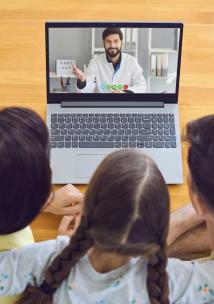Barnet residents have their say on remote GP appointments

The Healthwatch Barnet Research
In March 2020, NHS England issued guidance that GPs should embed a system of ‘total triage’ where patients contact their surgery remotely at first and only get seen face-to-face where it is deemed clinically required. Remote appointments include email consultations, video calls and telephone calls. As a result of these changes to GP services and in response to feedback from local people about their experiences of their GP’s new way of offering appointments, we set out to gather local people’s experience of accessing their GP remotely.
Throughout May, June and July, Healthwatch Barnet collected insight from people via 1-2-1 telephone interviews, community focus groups and a large online survey, speaking to a total of 376 people.
Our data includes experiences from people with disabilities, mental health challenges, learning disabilities, autism, hard of hearing/deaf, visual impairment and people whose first language is not English. The experiences also draw from various ethnic backgrounds and age groups.
Here at Healthwatch Barnet we understand the challenges faced by GP services in bringing in such an unprecedented scale of change at speed, challenges such as maintaining patient confidentiality, training staff and reaching the most vulnerable in our communities.
“The call was on time and all concerns were answered. For my particular needs on this occasion, this was better than face-to-face.”
Key Findings
Aspects people liked:
1. The new GP process
Before the appointment - ease of using the online booking system.
During the appointment - turnaround time from requesting an appointment and seeing your GP.
After the appointment - prescription collection working very well.
2. Convenience
Remote appointments were more convenient, quick and time-efficient for many reasons, i.e. not requiring travel to the surgery.
3. Personal Safety
Some people said they felt safer having a remote appointment with their GP compared to attending in person due to the risk of catching COVID-19.
“It’s much healthier than sitting in a waiting room filled with germs!”
Aspects people did not like:
1. The New GP Process
Before the appointment – the online form is lengthy, a longer waiting time for appointments and system inefficiencies resulting in increased access to more acute pathways.
During the appointment – scheduled appointment time slots too wide inconveniencing patients, patients feeling rushed or GP being late.
2. Patient Choice
Many people wanted the autonomy to choose between a face-to-face appointment and a telephone appointment.
3. ‘Digital Diagnosis’
Many people expressed a lack of confidence and trust in receiving a correct diagnosis over a remote appointment and felt face-to-face appointments were more appropriate.
4. Meeting Accessibility Needs
Remote appointments presented additional challenges for some older people, people with learning difficulties, autism, hearing difficulties, sight impairment, people whose first language is not English, and the digitally excluded.
5. Privacy & Data
Some people expressed concerns about their privacy, the data being shared on remote appointments, and finding an appropriate place to take the GP’s phone/video call.
6. Communication
Some people highlighted the gaps in communication with their GP and GP surgery, which also included other services such as hospitals and pharmacies.
7. Telephone calls
Patients who called the practice to book an appointment experienced longer waiting times
8. Frustration About Face-to-Face Access
Frustration with the lack of face-to-face access and feeling GP practices were playing catch up with the rest of society because other public sector services and organisations were open.
Read our report in full
You can read our report in full. Download it from the button below.
Summary version of the report
You can read a summary of the report via the button below.

